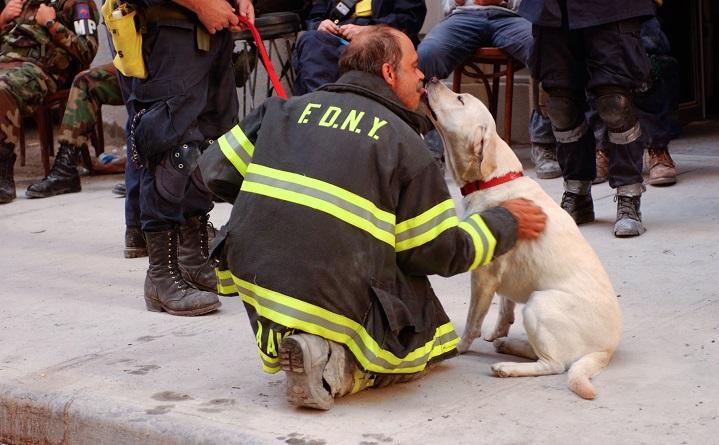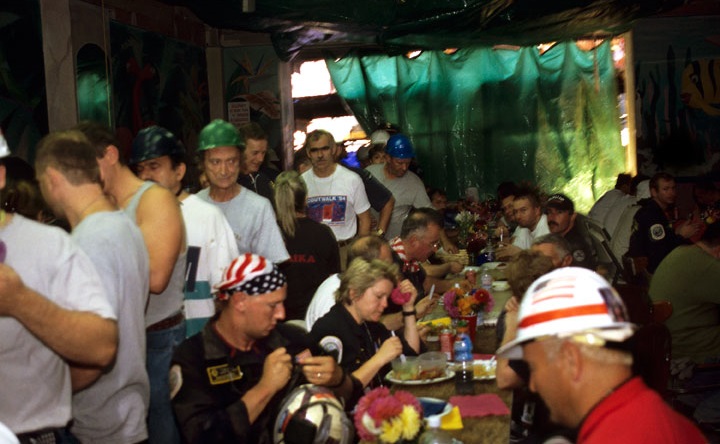Make a donation to the museum
“K-9 Courage” Honors the Comfort and Companionship Provided by Canine Responders
“K-9 Courage” Honors the Comfort and Companionship Provided by Canine Responders

In the hours and days following the attacks of September 11, 2001, rescue workers from across the United States responded to the crash sites. Joining the endeavor were hundreds of specially trained dogs. These furry, four-legged responders worked courageously and tirelessly alongside their handlers, searching for survivors and human remains and providing comfort to victims’ family members and rescue workers.
As the days passed at the World Trade Center site, rescue workers realized the chance of finding survivors was becoming increasingly slim. Despite the unlikelihood, the search continued. Dogs climbed huge piles of debris even as fires still burned beneath the rubble. The search was mentally and physically taxing for all involved.
Prior to the arrival of therapy dogs at Ground Zero, search and rescue dogs went beyond their specialized training to elevate the spirits of responders on site. Recovery workers approached and embraced the search dogs, which were brightening the dark days on the pile. Workers seeking a break hugged, petted, gave treats to, and played with the dogs.
“[The dogs] suddenly had been given another responsibility that they weren’t prepared for,” recalled Dr. Patrice Klein, a veterinarian who responded to Ground Zero with a Veterinary Medical Assistance Team. “If [recovery workers] saw a search and rescue dog, even just sitting, resting, they would come over because they needed that compassionate moment. It wasn’t that dog’s responsibility nor training to be a therapy-type dog, but by default they became something warm and wonderful and living, that you could take two seconds to just put your hands on a dog and just feel compassion for something.”
Despite providing an obvious benefit for rescue and recovery workers, the search and rescue dogs themselves needed a rest after canvassing the debris pile day after day. In late September, trained therapy dogs eventually were brought to the scene in to provide comfort to workers.
In addition to having completed extensive training to work in emotionally charged environments, therapy dogs must be gentle, calm, obedient, and comfortable around strangers in new settings. Utilizing their training and innate nature, therapy dogs provided warmth and affection at the World Trade Center site and at family assistance centers in New York City and Virginia.
Frank Shane, a therapy dog handler who spent months at Ground Zero with his canine partner, Nikie, worked until the site was cleared and even took part in the Last Column ceremony by handing out flags to recovery workers. In an interview with the 9/11 Memorial Museum in 2008, Shane recalled the importance of therapy dogs:
“People want a teddy bear,” Shane said. “They want something that grounds them to a period in time that’s safe because everything else is just chaotic."
K-9 Courage, a past exhibition at the 9/11 Memorial Museum, tells these stories and honors these brave canine responders.
By Elizabeth Fischetti, Exhibition Coordinator, 9/11 Memorial & Museum
Previous Post
Food for the Soul: The Restaurants of Ground Zero

In the days following 9/11, chefs, charitable organizations, and volunteers with a zest for cooking answered the call to help their fellow New Yorkers, joining together as a community to share food for both body and soul.
Next Post
Learn With Us Online
Although the 9/11 Memorial & Museum is temporarily closed, we are committed to providing relevant and engaging learning opportunities for students, teachers, families, and the general public. We have moved several educational resources online to support you while at home.